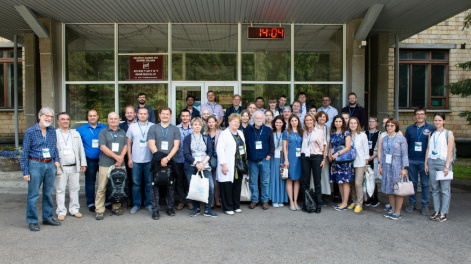Krasnoyarsk for the first time in Russia brought together specialists in the field of aptamer research
10 September 2019 г.

Aptamers are small fragments of DNA or RNA which are able to “recognize” other molecules and bind to a specific target molecule. They are used to measure the concentration of various metabolites and proteins, to detect toxins, and to identify specific types of cells and tissues, for example, tumor microorganisms or pathogens. These molecules can be used in physics, chemistry, agriculture and other fields, and their specific properties are promising for medicine.
At the conference, researchers united by molecular science discussed various aspects of dealing with aptamers, from their selection, synthesis, properties and structure to their application in therapy and diagnosis. Stephen Benner, Ph.D. in Chemistry, founder of the Westheimer Institute of Science and Technology presented a paper on artificial synthetic DNA and RNA-like systems. They are built of eight chemically modified nucleotides or “letters” and form four complementary pairs with each other. Aptamers based on them have a specific structural regularity and functionality. They have the potential for new features, such as self-assembling, encoding, storage and transmission of information.
In order to deal with objects of this size and complexity new methods are required. Roman Moryachkov, a researcher at the Laboratory for Digital Controlled Drugs and Theranostics KSC SB RAS, told about the application of small-angle X-ray scattering (SAXS) in determining the spatial structure of aptamers. Our scientists carry out this research using synchrotron radiation facilities located in Moscow, Hamburg or Grenoble. It is possible to reconstruct the three-dimensional shape of a molecule and build a molecular model from it based on the analysis of the x-ray scattering patterns after the radiation has passed through a solution with aptamers.
Molecular modeling based on SAXS data allows one to obtain the spatial structure of DNA and RNA molecules, to study the interaction with protein targets, as explained the scientist of the L.V. Kirensky Institute of Physics, Felix Tomilin. This will aid in improving methods of selecting aptamers, optimizing the operation of devices used to diagnose diseases.
Anastasia Shabalina, Candidate of Chemical Sciences, senior research associate at the Laboratory of New Materials and Advanced Technologies at the V.D. Kuznetsov Siberian Physical and Technical Institute, told in her report about biosensors based on the aptamers. The researcher noted that aptasensors can diagnose diseases, for example, cancer or multiple sclerosis, in the early stages. It also seems promising to create sensors with multiple aptamers which are able to capture various proteins and diagnose various diseases.
The highlight of the conference was the presentation by the developer of the aptamer selection method Larry Gold, who figured out 30 years ago how to perform the in vitro directed evolution of short RNAs to obtain a chain with the best binding to T4 bacteriophage DNA polymerase. The US National Academy of Inventors made him one of his fellows in 2017. The presence of the aptamer inventor proves the international recognition of the event.
The conference was the first in Russia in the field of aptamer research. It gathered more than a hundred scientists from many regions of Russia and several countries of the world. There is a reason why the Krasnoyarsk Science Center SB RAS is one of its organizers. It is here that in the framework of the implementation of the national project "Science", the Laboratory of Controlled Digital Drugs and Theranostics has recently been created. There, in joint projects with the V.F. Voyno-Yasenetsky Krasnoyarsk State University scientists develop and investigate aptamer technologies for diagnosing and treating socially significant diseases, for example, they are studying the structure of aptamers to improve targeted drug delivery. A priority for the Krasnoyarsk Science Center SB RAS is the development and implementation of molecular techniques to fight cancerous tumors. With the help of aptamers, scientists have learned to diagnose certain types of cancer and, probably, even to fight them. Aptamers also aid scientists in detecting diabetes and multiple sclerosis in the early stages.
“This is our first experience in organizing an event dedicated to such an interesting and complex topic as aptamers. Recently, an interdisciplinary laboratory for aptamers was established at the center, bringing together physicists, chemists, medical professionals and biologists. This is a very important and promising area which will be supported and developed by our Center, ” says Nikita Volkov, Director of the Krasnoyarsk Science Center SB RAS, Doctor of Physical and Mathematical Sciences.
The conference proceedings are published in a special issue of the journal Molecular Therapy Nucleic Acids. Another international scientific journal, Biomedicines, established prizes for young scientists for the best poster presentations. Their winners are Daria Sharko (Tomsk) and Tatyana Smolyarova (Krasnoyarsk).
After the conference, foreign and Russian experts in the field of molecular biology, chemistry and therapy performed a seminar for young scientists at the V.F. Voyno-Yasenetsky Krasnoyarsk State Medical University.
“The conference participants emphasize that the event was exceptional, unlike other conferences. In addition to oral reports by widely known scientists and talented youth, time was allocated for the researchers to communicate with each other in unusual and interesting conditions. There were excursions, trips, a party near a bonfire with wine and tea from a large samovar boiled on cones and, of course, a traditional banquet.
Students and post-graduates, together with eminent scientists, considered not only urgent issues in this field of science, but also explored the “eternal” space through a telescope, sang songs with a guitar until nightfall, went to Stolby, sailed on a boat and even went swimming in the Krasnoyarsk Sea. What is especially valuable, people who used to know us only by scientific articles now write letters, thanking for the warmth and care. I would like to thank everyone who made this unforgettable event possible - the organizing committee, sponsors, participants, ” says Anna Kichkaylo, Doctor of Biological Sciences, Head of the Laboratory of Digital Controlled Drugs and Theranostics.
Share:
